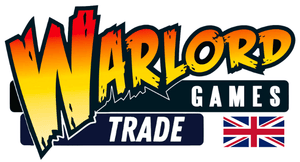Products
-
8th Army starter armyGet ready to build and battle across North Africa with the British 8th Army starter army box set! The British 8th Army comprised of men from around the British Commonwealth - Australians, New Zealanders, South Africans, Indians and Polish troops all joining their British...
-
A34 Comet heavy tankDeveloped from the need for a British tank capable of taking on the potent German Panther and Tiger tanks, the A34 Comet medium tank was effectively the next generation of the Cromwell medium tank. The Comet’s low silhouette was bolstered by thick armour, with...
-
Afrika Korps Starter armyWith the Infamous 88, a Panzer III tank and 30 + men to command this is the German Afrika Korps Starter army you must have! Sent to North Africa to bolster the Axis war effort in the Western Desert, the Deutsches Afrika Korps, under...
-
Banzai! Imperial Japanese Starter ArmyBoxed set contains the following: 1 metal officer 48 plastic infantry 1 metal medium mortar team 1 metal medium machine gun team 1 plastic Type 97 Chi-Ha medium tank Bolt Action stat card Vehicle damage markers The contents of the boxed were based on...
-
Char B1 bisUpgrading the Char B1, the Char B1 bis had thicker armour and an APX4 turret with a longer-barrelled (L/32) 47 mm SA 35 gun, giving it more anti-tank capacity alongside the 75mm hull-mounted howitzer. French experiences during The Great War influenced their belief a...
-
Flakpanzer IV Wirbelwind (resin)One of several anti-aircraft vehicles to utilise the reliable and ubiquitous Pz IV chassis, the Wirbelwind (Whirlwind) mounted a quad-barreled Flakvierling 38 on an open-topped turret. Around 100 Wirbelwinds were produced in the latter half of 1944, fulfilling the German requirement for a self-propelled, multi-barrel...
-
Japanese Type 95 Ha-Go light tankThe Type 95 Ha-Go light tank was the most numerous armoured fighting vehicle fielded by the Japanese during WWII. It also saw action against the Soviet Union at Khalkhin Gol in 1939 and during the Sino-Japanese war of 1937-45. It saw action in both Imperial...
-
M24 Chaffee, US light tankInitially produced as a replacement for the M3/M5 Stuart light tanks, the armour of the M24 was purposely kept light, with a glacis plate only 25mm thick (although its heavy slope increased its effectiveness). A vastly upgraded lightweight 75mm gun (compared to the 37mm...
-
M7 Priest self-propelled gunThe 105mm Howitzer Motor Carriage (HMC) M7 was the workhorse of US Army motorised artillery units, allowing unparalleled close fire support. Built on the ubiquitous M4 Sherman hull, the open-topped superstructure held a 105mm howitzer supported by a .50 cal heavy machine gun on...
-
Marder IIIMarrying the obsolete but reliable chassis of the Czech-built Pz 38(t) tank and the captured Soviet 76.2mm PaK 36(r) L/51 anti-tank gun, the Marder (Marten) provided the Wehrmacht with a potent self-propelled gun. These captured Soviet weapons were rechambered to accept German 75mm PaK...
-
Panzer 38(t)Most commonly known as the Panzer 38(t), this light tank was originally a Czech design – the LT vz. 38 – which fell under the Third Reich's control when Germany occupied Czechoslovakia in 1938. The 't' in its designation relates to the German for...
-
Puma Sd.Kfz 234/2 Armoured CarThe Puma is, arguably, one of the best-looking armoured cars of WWII. A variant of the Sdkfz 234 it boasted a fully enclosed turret with a 5cm gun and thicker armour than other variants. Despite this additional armour the Puma was still capable of...
-
Sd.Kfz 184 Elefant heavy tank destroyerBased on the Ferdinand heavy tank destroyer, the Elefant was designed to overcome the deficiencies and mechanical failures experienced at the Battle of Kursk in 1943. The 89 Ferdinands committed at Kursk claimed to have knocked out over 300 enemy tanks, for the loss...
-
T-34/85 medium tank (plastic)The T-34 series, with its sloping armour, changed the principles of tank design during the war. The sloping, angular layout of the T-34 increased the effective armour thickness and also saw a larger proportion of shells deflected away than penetrated its armour. The introduction...





























